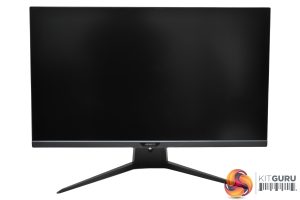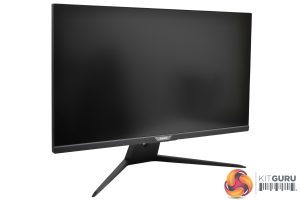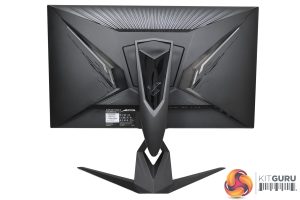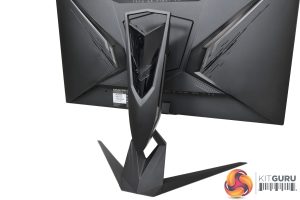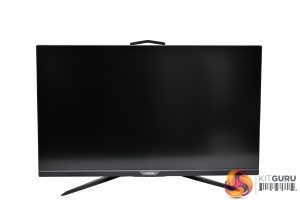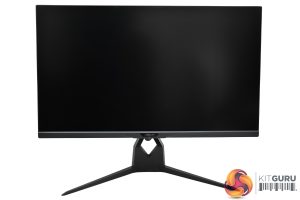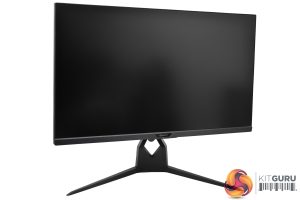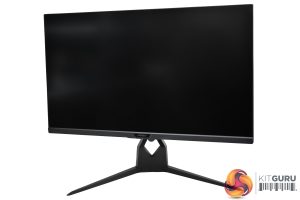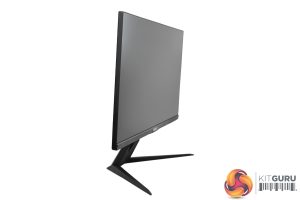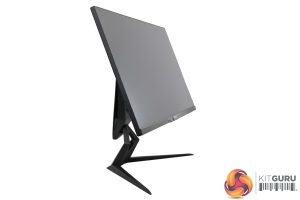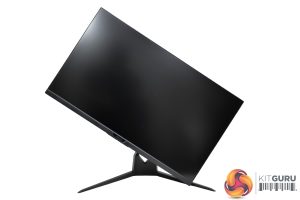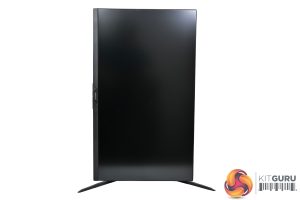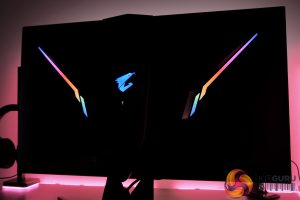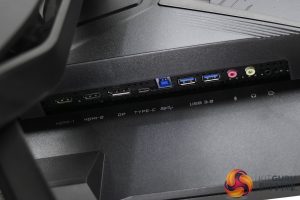If we start the review with a look at the design of the FI32Q X, it's pretty clear that this is a gaming monitor. It sports a wide, v-shaped stand, while the rear of the panel is full of aggressive angles and sharp edges. This is less obvious from the front, but there is some angulation around the Aorus logo on the bottom bezel, and that logo itself is a bit of a giveaway, too.
Personally I prefer simpler, more minimalistic designs, but like I say, when viewed from the front the design isn't too aggressive, and I didn't bother me during my usage.
As for the stand, this is made of metal and offers a full array of ergonomic adjustments. We find up to 130mm of height adjustment, 20 degrees of swivel in both directions, tilt from -5 degrees to +21 degrees, and even full 90 degree pivot, so you can use this screen vertically if you want.
There's the added bonus that the FI32Q X supports VESA 100 mounting brackets too, so if you already have a third-party monitor arm or wall mount, that is supported. Additionally, as we show in the video, if you are not too happy with the large v-shaped base of the stand, Gigabyte actually includes a desk mount for the monitor in the box, and it takes up significantly less space on your desk, so that is definitely a welcome inclusion in my book – though no doubt it also contributes to the £900 asking price…
Other things to mention include the small joystick used to navigate the OSD, which is positioned on the underside of the bottom bezel.
And how could we forget the monitor's RGB lighting? This is positioned on the rear of the display, and judging by the responses on Twitter, most people aren't fussed about this – but you can always turn it off.
As for the I/O, the right side of the monitor is home to the power input. On the left, we find a full array of ports – 2x HDMI 2.1 and 1x DisplayPort 1.4 video outputs, plus 1x USB Type-C DP Alt. Next to those, there's a USB upstream input and its two corresponding USB 3.0 downstream ports, as well as both mic and line out options. The headphone jack is worth mentioning as it uses an ESS SABRE DAC. I personally have never plugged my headphones into my monitor so I am not sure how many will use this feature, but it is worth pointing out.
Lastly, it is worth confirming the state of play in terms of the HDMI 2.1 ports. There's been some ‘fun and games', shall we say, around the HDMI 2.1 standard in the last six month, and the last time we looked at an Aorus monitor, its HDMI 2.1 ports were limited to 24Gbps, instead of the full 48Gbps bandwidth. After speaking with Gigabyte, we can confirm the same is in place here with 24Gbps HDMI 2.1 ports being utilised.
That in itself shouldn't be a problem as the FI32Q X is a 1440p display, however I did encounter an issue where two Nvidia GPUs refused to run at 240Hz over HDMI – but an AMD RX 6900 XT hit 240Hz without a problem. All three GPUs worked perfectly over DisplayPort too so I am not quite sure what is going on here, but we've reached out to Gigabyte with our findings and will update this review as and when we hear back.
Update 28/04/22: Gigabyte got back to us on the issue and it seems it was a fault with the Nvidia driver. We no longer have the FI32Q X to verify this, but we have been informed by Gigabyte that the issue is no longer present with Nvidia GPUs when using the latest driver.
 KitGuru KitGuru.net – Tech News | Hardware News | Hardware Reviews | IOS | Mobile | Gaming | Graphics Cards
KitGuru KitGuru.net – Tech News | Hardware News | Hardware Reviews | IOS | Mobile | Gaming | Graphics Cards


